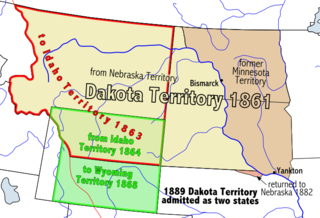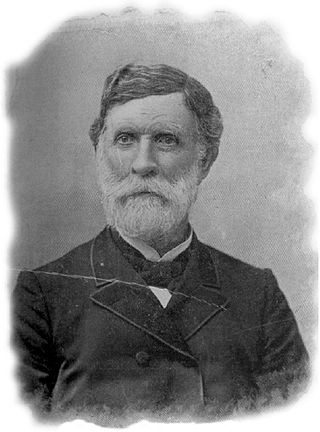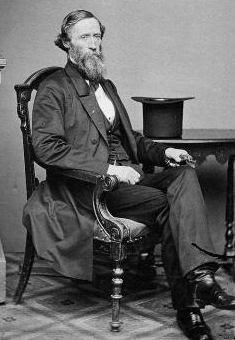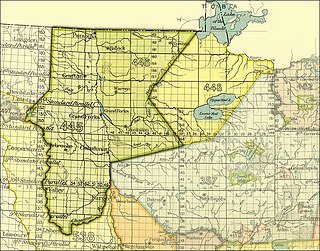Related Research Articles

The Sioux or Oceti Sakowin are groups of Native American tribes and First Nations peoples from the Great Plains of North America. The Sioux have two major linguistic divisions: the Dakota and Lakota peoples. Collectively, they are the Očhéthi Šakówiŋ, or "Seven Council Fires". The term "Sioux", an exonym from a French transcription ("Nadouessioux") of the Ojibwe term "Nadowessi", can refer to any ethnic group within the Great Sioux Nation or to any of the nation's many language dialects.

Pembina County is a county in the U.S. state of North Dakota. At the 2020 census its population was 6,844. The county seat is Cavalier.

The Territory of Dakota was an organized incorporated territory of the United States that existed from March 2, 1861, until November 2, 1889, when the final extent of the reduced territory was split and admitted to the Union as the states of North and South Dakota.

Walter Atwood Burleigh was an American physician, lawyer, and pioneer. He represented the Dakota Territory as a non-voting delegate to the United States House of Representatives.

Wilmot Wood Brookings was an American pioneer, frontier judge, and early South Dakotan politician. He was provisional governor of the Dakota Territory, and both the cities of Wilmot and Brookings as well as the county of Brookings, South Dakota are named for him.

The Pembina Region, also referred to as the Pembina District and Pembina Department, is the historic name of an unorganized territory of land that was ceded to the United States in 1818. The area included the portions of what became the States of Minnesota, North Dakota, and South Dakota lying within the Hudson Bay drainage basin. The area included settlements in the Pembina River area. The region was formerly part of British Rupert's Land, granted by British royal charter to the Hudson's Bay Company. After the Selkirk Concession and establishment of the agricultural Red River Colony in 1812, the area was governed as the District of Assiniboia. The Treaty of 1818 de jure transferred the region south of the 49th parallel to the United States from the British. Settlements south of the boundary continued to be de facto administered as part of Assiniboia until at least 1823.

Newton Edmunds was an American politician who served as the second Governor of Dakota Territory, serving during the American Civil War.

John Blair Smith Todd was a Delegate from Dakota Territory to the United States House of Representatives and a general in the Union Army during the American Civil War.

Andrew Jackson Faulk was an American politician. He served as the third Governor of Dakota Territory.

Nehemiah George Ordway was an American politician who was a New Hampshire state senator and the seventh Governor of Dakota Territory. Ordway was regarded as one of Dakota Territory's most controversial governors.
This article deals with the history of Sioux Falls, South Dakota.
Medary is an unincorporated community in Brookings County, South Dakota, United States. Founded in 1857 by the Dakota Land Company, it was one of the first towns in South Dakota. It is not tracked by the U.S. Census Bureau.

The history of South Dakota describes the history of the U.S. state of South Dakota over the course of several millennia, from its first inhabitants to the recent issues facing the state.

By the Treaty of Old Crossing (1863) and the Treaty of Old Crossing (1864), the Pembina and Red Lake bands of the Ojibwe, then known as Chippewa Indians, purportedly ceded to the United States all of their rights to the Red River Valley. On the Minnesota side, the ceded territory included all lands lying west of a line running generally southwest from the Lake of the Woods to Thief Lake, about 30 miles (48 km) west of Red Lake, and then angling southeast to the headwaters of the Wild Rice River near the low-lying divide separating the watershed of the Red River of the North from the watershed of the Mississippi River. On the North Dakota side, the ceded territory included all of the Red River Valley north of the Sheyenne River. The total land area, roughly 127 miles (204 km) wide east to west and 188 miles (303 km) long north to south, consisted of nearly 11,000,000 acres (45,000 km2) of rich prairie land and forests.

The Yankton Sioux Tribe of South Dakota is a federally recognized tribe of Yankton Western Dakota people, located in South Dakota. Their Dakota name is Ihaƞktoƞwaƞ Dakota Oyate, meaning "People of the End Village" which comes from the period when the tribe lived at the end of Spirit Lake just north of Mille Lacs Lake. The CNWRR records state the name is alternately spelled with an "E" instead of an "I" or "Ehanktowan".
Frank M. Ziebach was a noted political figure in the Dakota Territory during the territorial period from 1861 to 1889. He was a pioneer newspaperman, founding a number of newspapers in the Iowa and Dakota Territories, including the Yankton "Weekly Dakotan" in 1861, which is still published today as the Yankton "Press and Dakotan". He was known as the "squatter governor" of the Dakota Territory. Ziebach County, South Dakota was created in 1911, and is named for him.
William Tripp was an American politician, lawyer, soldier, and surveyor.
Peter C. Shannon was an American lawyer, politician, and judge. After practicing law for a time in Pittsburgh, Pennsylvania, in 1852, Shannon ran unsuccessfully for a seat in the US House of Representatives, losing by five hundred votes to Whig David Ritchie. Shannon was then appointed president judge of the local district court in 1852 by Pennsylvania Governor William Bigler, but served for only a year, having been defeated for re-election in 1853. At the beginning of the Civil War Shannon became a Republican and was elected to the Pennsylvania House of Representatives, serving two terms, 1862 and 1863. He was commissioned Lieutenant Colonel in a regiment which he helped raise, but resigned to continue his political career. In 1862 he campaigned with Governor Andrew Curtin in his successful re-election bid, and in 1864 was part of Lincoln's re-election campaign in Pennsylvania.
Downer Tenney Bramble was an American pioneer businessman and politician in Dakota Territory.
This timeline of South Dakota is a list of events in the history of South Dakota by year.
References
- ↑ http://www.biographi.ca/en/bio/stutsman_enos_10E.html "Stutsman, Enos", Hartwell Bowsfield, Dictionary of Canadian Biography, Volume X (1871-1880)
- ↑ Kingsbury biography of Stutsman
- ↑ Bismarck Tribune article on Stutsman
- ↑ Dictionary of Canadian Biography, entry "Enos Stutsman"
- ↑ The Brewster Standard, April 27, 1894, "Won By Two Deuces", p. 2 [ permanent dead link ]
- ↑ South Dakota Historical Society Foundation, March 2012 newsletter
- ↑ Prairie Public Broadcasting, Dakota Datebook, "Enos Stutsman", February 14, 2005
- ↑ "Lincoln's Legacy" at history.nd.gov